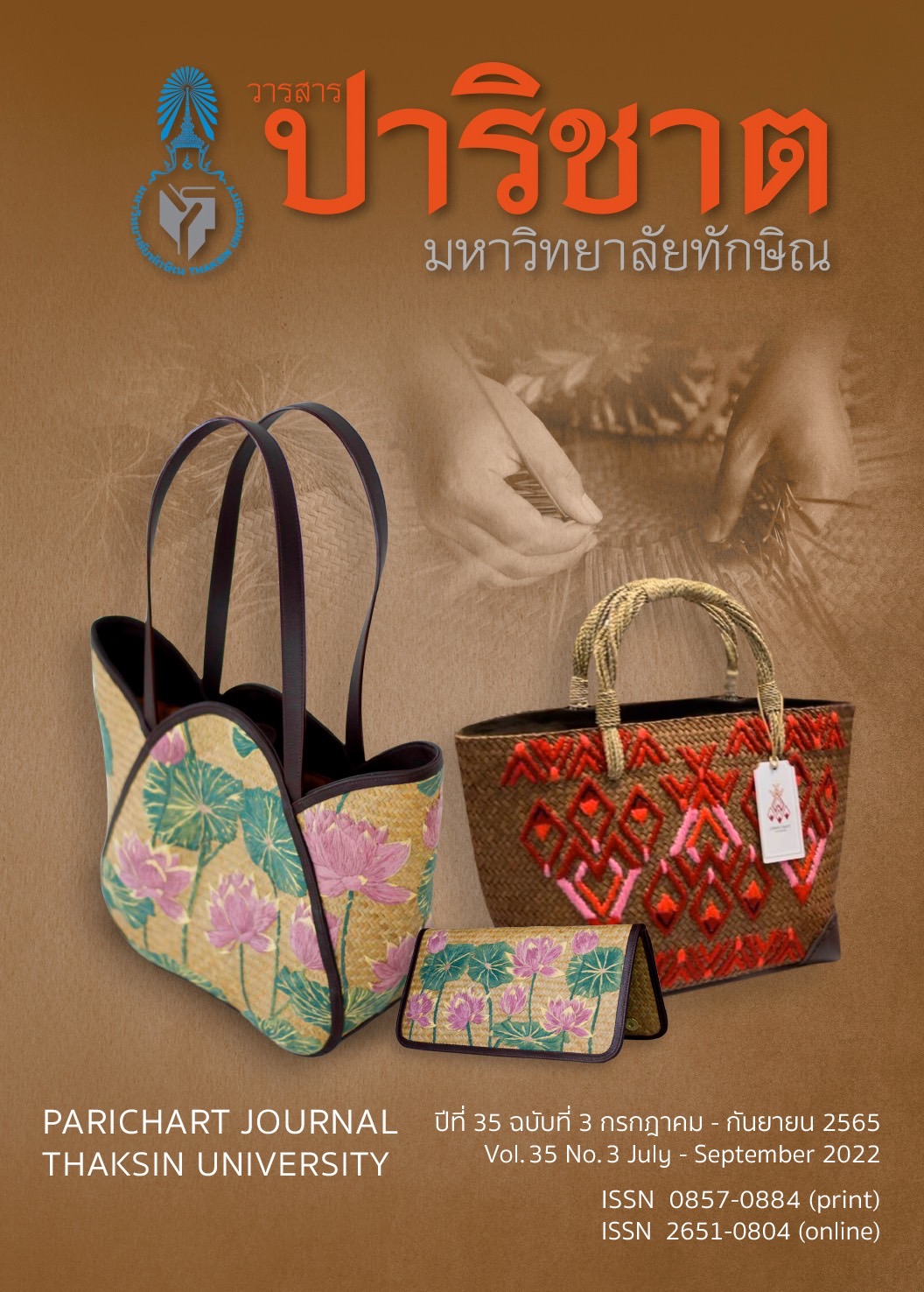The Politics of Marriage: From ‘Burmese Laborers’ to be ‘Kon Song Nam’ in Ranong Border
Main Article Content
Abstract
The existence of ‘Khon Song Nam’ or ‘people with dual citizenship’ in Ranong is an important condition to level up the economic status of Burmese laborers. In fact, the way to have legal dual citizenship has been sought. Burmese laborers in B.E. 2550 tried to find out a way to have legal status by marriage. Hence, the scope of ‘Khon Song Nam’ has been extended. That is, ‘Khon Song Nam’ was first limited in two characteristics: relatives who were unofficially native and fake identities of deceased people, which have been difficult to do. Nowadays, marriage has been popular because it is easier and quicker than other ways. Having Thai husbands or wives can assist to enhance the legal status of their work. In consequence, their economic status and well-being have significantly been better. Border studies, such as in Ranong, are necessary to consider a ‘border’ in a dimension of a ‘connected city’. Therefore, the complexity to find out the way of self-changes to live with status can be understood
Article Details

This work is licensed under a Creative Commons Attribution-NonCommercial-NoDerivatives 4.0 International License.
References
Office of the National Economic and Social Development Council. (2018). Gross regional and provincial product chain volume measures 2018 Edition. O.S. Rriting House. (In Thai)
Senakum, T. (2004). The concept of displacement and ethnicity cited in Chaweewan Prachuabmao. ethnicity. The Princess Maha Chakri Sirindhorn Anthropology Centre.
Pongaumpornsakda, P. (2011). The problems of Myanmar migrant workers providing sex services: A case study of Ranong Province. Thesis of Master of Arts in Political Science in Security Resource Management. Burapha University. (In Thai)
Archavanitkul, K. (1997). Complexity and confuse of cross-border people in Thailand. Institute for Population and Social Research, Mahidol University. (In Thai)
Ranong Immigration Office. (2019). Retrieved 2 April 2020, from https://www.ranongimmigration.go.th/content/history. (In Thai)
Pocapanishwong, N. (2013). Translocality: The interaction of peoples in borderland and the negotiation in religious sphere of the transnational Burmese migrant in Ranong Province. Thesis of Doctor of Philosophy in Interdisciplinary Studies. Bangkok: Thammasat University. (In Thai)
Memorandum of Ranong Provincial Hall on 28th September 1994. Burmese Diasporas in Ranong Province cited in Meekul, P. (1995). Problems and solutions of using Illegal Burmese labors: a case study of Ranong. Thesis of Master of Political Science in Public Management. Thammasat University. (In Thai)
Ranong province. (2016). Economic conditions of Ranong. Retrieved 29 April 2020, from https://www.ranongcities.com/2561/content/economy. (In Thai)
Tanamai, R. (2004). The political economy of Thai-Myanmar relations: a case study of border areas in Ranong Province. Thesis of Master of Arts in International Relations. Thammasat University. (In Thai)
The 8/8/88 Uprising in Mayanmar. (2013). Retrieved 29 may 2020, from https://guru.sanook.com/26507/. (In Thai)
Htut, U. Interviewed on 6 March 2015 cited in Chotisut, K. (2016). Aung San: Collective memory of Burmese migrant workers in Ranong Province. Thesis of Master of Arts in Southeast Asian Studies. Walailak University. (In Thai)
Archavanitkul, K. et al. (1997). Synthesis of alien labor situations and alternative policy of alien labor import in Thailand. In the National Research Conference of Alternative Policy of Alien Labor Import in Thailand: a Study of Facts from Beneficiaries, Law Observation, and Analysis of Government Management System. 30-45. May 26-28, 1997. Institute of Population and Social Research, Nakhon Pathom. Nakhon Pathom, Mahidol University. (In Thai)
Treechot, P. (1998). Problems of hill-tribe groups in Thailand-Myanmar borders: a study of effects on international trade between Thailand and Myanmar. Chulalongkorn University. (In Thai)
Interview. Sia Khao. Thai immigrant and the owner of a Shell Gas Station in Ranong. 52 years old. August 11, 2020. (In Thai)
Interview. Kothong. Local citizen and the owner of Kitpaisan Limited Partnership. 66 years old. August 26, 2017. (In Thai)
Interview. Teacher in Pak Chan. Local citizen. August 22, 2021. (In Thai)
Interview. Kanda (an assumed name). Burmese labor from Dawei. 26 years old. January 20, 2021. (In Thai)
Interview. Mae Kaew (an assumed name). Burmese labor from Bokpyin and marriage to Thai husband. January 24, 2019. (In Thai)
Interview. Ipew (an assumed name). Burmese labor from Dawei and marriage to Thai husband. 26 years old. January 24, 2021. (In Thai)
Archavanitkul, K. et al. (2000). Genders, reproductive health, and violence: Life experiences of Burmese labors. Institute for Population and Social Research, Mahidol University. (In Thai)
Kerdmonkol, A. (Editorial). (2003). Life diaries of Burmese labors: from slave labors to illegal labors. Bangkok: Thai Action Committee for Democracy in Burma (TACDB). (In Thai)
Koonphol, S. (2007). Stories of everyday life, Political Science Journal (Faculty of political science), Vol. 28 No. 2. (In Thai)


